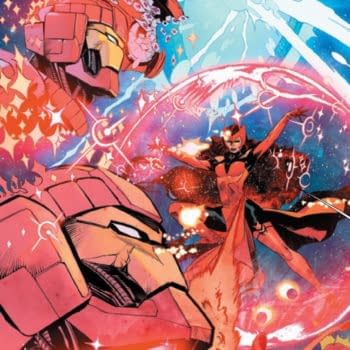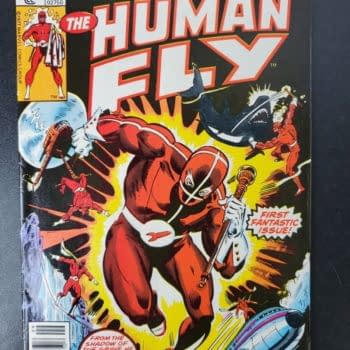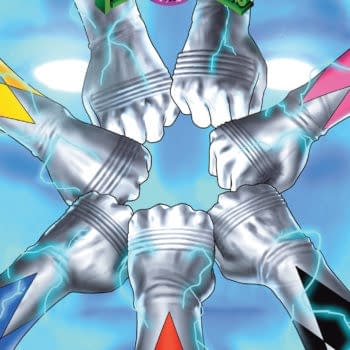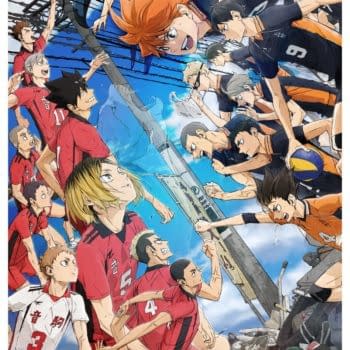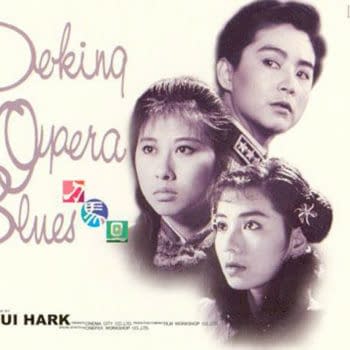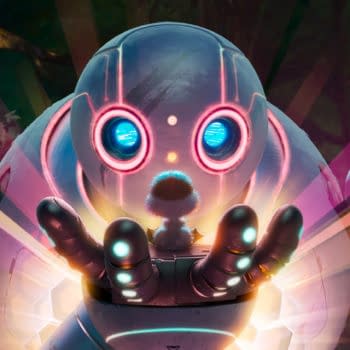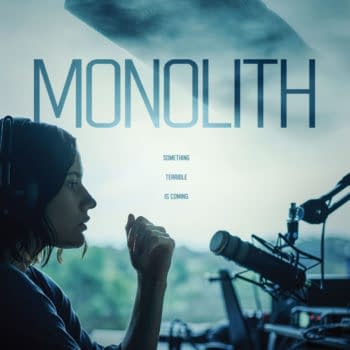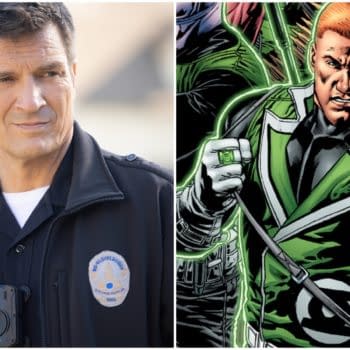Posted in: Movies | Tagged: entertainment, film, godzilla
Godzilla, Then And Now – Look! It Moves! by Adi Tantimedh
Adin Tantimedh writes,
So. New Godzilla movie from Hollywood.
Godzilla has been a malleable and evolving symbol since the first movie in 1954. Back then, it wasn't a campy monster fest but a sombre meditation on the despair of post-war Japan and the horrors of nuclear devastation with the monster standing in for not just the atom bomb but karmic payback for Japan's part in the Second World War. It also dealt with the unfair class structure in Japan, featuring the Barakamin, a group of impoverished farmers oppressed and shunned by mainstream society. It was a bleak and tragic movie filled with guilt and loss that the West never actually saw until the 1990s. Until then, Americans and Europeans had only seen the recut and dubbed Godzilla, King of the Monsters, which edited out many scenes of social depravation and bleakness and inserted close-ups of Raymond Burr spouting exposition describing what viewers were already watching onscreen.
That first movie was the first and only time Godzilla was portrayed as a harried and angry animal doing what they do under those circumstances: lash out before being unjustly killed by humans in fear and desperation. It was an expensive (for Japan) A-list production filled with social contexts and disgust with social injustice. He ate commuters, the first and last time he ate people in a movie.
After it became a hit, a whole monster movie genre and industry was born in Japan and Godzilla became a franchise and piece of merchandise for kids. By the 60s and 70s, he was turned into a good guy, his face redesigned with bigger eyes and rounder, cuter features as he was presented as something more child-friendly and fighting baddie kaiju to protect Japan. Godzilla and Osamu Tezuka's Astro Boy became the symbols of the normalization and domestication of nuclear power in Japan. They even gave him a son Minya to show he's a good dad who takes junior out on kaiju fights and looks out for him. I always wondered why Minyawas designed to look like a naked old Japanese guy with dementia who's been painted green and sent out for a walk, but anyway, onwards.
Western fans knew Godzilla by those Sixties and Seventies campy movies with their bad dubbing and increasingly odd plots, and kids identified with Godzilla because he represented to them a pleasing vision of their id: being able to stomp on things and break them and yet everyone still loves them. It's the same appeal The Hulk holds for kids, the fantasy of expressing destructive rage and energy, but Godzilla suffered far less consequences. To me, the Seventies Godzilla movies also represented the odd, meandering silliness of the 1970s. He was so taken for granted that they even had movies like Godzilla vs. Megalon where he wasn't even the main character but just showed up at the end to help out the movie's main character, a giant robot designed by fans in a children's contest whose look was influenced by the equally popular Ultraman. My parents took us to see this one at the drive-in on a Tuesday night when I was six. It was great fun.
The Heisei era of the Godzilla movies (1984-1995) rebooted Godzilla in a series of seven movies that had their own continuity and recurring cast. Here Godzilla was reconfigured as a monstrous, unstoppable force of nature to be feared, avoided and hopefully directed elsewhere, wrecking destruction wherever he went, mostly Tokyo. It's interesting to note that this series of movies were made in the 80s when Japan's economic ascendency was at its peak and looked unstoppable, prompting paranoid Western fantasies about an all-powerful Japan taking over the world. In Godzilla vs. King Ghidorah, time-travelling aliens who could be read as standing in for the USA, try to con the Japanese into preventing the detonation of the atomic bomb that gave birth to Godzilla so that their kaiju, King Ghidorah, can take over the world, so the Japanese heroes have to make sure Godzilla gets created after all in order to save the world (or rather Japan, since that's how the Japanese see Japan) from these evil conquering American – I mean, aliens. Godzilla was effectively Japan, not a people or a nation, but a force. The second half of these movies take place in the 1990s, after Japan's economic bubble burst and the country was plunged into despair and uncertainty, and that vibe ended up in the movies as well. The final movie in the series, Godzilla vs. Destroyah, features a dying Godzilla, his nuclear heart overheating and threatening to meltdown, in his final battle where his death would result in a nuclear catastrophe that would destroy the whole world. This is a far cry from the campy 70s movies, even despite the dreadful dubbing of the English version. Godzilla dies at the end, melting down from the heat of his own heart going nuclear, but the end of the world is averted, though Tokyo is reduced to an uninhabitable, radioactive wasteland. It's a surprisingly bleak and elegiac movie, seeming to reflect Japan's own fear of total collapse and obsolescence.
The Godzilla movies of the 2000s weren't as consistent in quality or focus. Godzilla was back being the bad guy that Japan has to fight. Shusuke Kaneko's Godzilla, Mothra, King Ghidorah – Giant Monsters All-Out Attack was the best one, reconfiguring Godzilla as a supernatural creature containing the souls of all the dead from World War II threatening karmic payback against Japan. The last Japanese movie, 2004's Godzilla: Final Wars, hated by hardcore fans, was like a last hurrah, a campy, poppy, gleefully ridiculous celebration of Godzilla as pop icon, the king of Japanese pop culture as he stomps and romps through a greatest hits series of fights against Japan's movie dai kaiju even as pretty heroes with superpowers who looked like a boy band battled campy alien invaders in slo-mo kung-fu fights nicked from The Matrix. The baddie aliens here are too goofy to be America. Instead, I find myself reading this movie as an allegory for the Japanese pop industry in transition and the aliens as arrogant, obnoxious new executives with MBAs attempting a hostile takeover of the industry, only to be thwarted by Godzilla.
"I'm the King of Pop, fuckers!" he seemed to roar as he headed off into the sunset. "You're gonna miss me when I'm gone!"
The new movie is a mixed bag. Again, it reconfigures Godzilla as a symbol. If you take Godzilla as a single guy from the first movie to the latest one, you can trace a trajectory from youthful rebellious, violent debut to children's star to series actor before retirement, only to be trotted out again, older, more tired but still the best at what he does.
Godzilla here is the Dai Kaiju police. Ken Watanabe's character says he's here to "restore balance", which means save the world from the bad Kaiju, an idea nicked from Kaneko's Gamera Trilogy. How does this work? How does Godzilla, who's said to be lying dormant the bottom of the Pacific Ocean, even get wind of a bad kaiju popping up on the surface world? Is there a kaiju Commissioner Gordon who got on the phone and called Godzilla while he was either asleep, hanging out with a supermodel kaiju or playing Call of Duty multiplayer and tell him he's needed? You can imagine Godzilla muttering "I'm getting too old for this shit" as he drinks his breath tonic to have a couple of hits of atomic breath ready to hock at the baddie kaiju and stomps out the door, hoping he didn't forget to set the DVR to record the finale of Breaking Bad.
I'm wondering what Godzilla stands for in this movie, what the subtext is here, and the fact that he's presented as a benign but dangerous entity means he can be read as positive military intervention. We're meant to be grateful for Godzilla saving the day by the end, even if he did kill a lot of people inadvertently (and indifferently) when he caused the Tsunami, and probably stepped on people, but then we didn't see them die, so that's okay. The metaphors in this movie are very muddled, throwing in allusions to nuclear disasters like Fukushima, evoking images of a world ravaged by Global Warming, even having Godzilla cause a Tsunami, throwing in scenes of benign military intervention and 9/11 levels of urban destruction to tick off all the images of global zeitgeist anxieties. This being a Hollywood movie, of course the emphasis would be on the preservation of a nice nuclear family, even if they don't have any personality. In the end, this is a Godzilla that's been co-opted by the Establishment, saving and preserving the status quo instead of a threat to it. Godzilla is now The Man.
That Godzilla is barely in 20 minutes of the two hours of this movie is baffling. He's been reduced to a cameo in a movie called Godzilla. The baddie kaiju have more screentime than he does in the two hours. Godzilla doesn't even have anything to do with the main plot at all. All the trailers gave us the impression that the nuclear plant meltdown that kills Juliet Binoche was caused by Godzilla and that the world was in danger from Godzilla for the rest of the movie, which is a brilliant bit of marketing. That set us to expect an epic Godzilla movie. Instead, all the death and mayhem is mainly caused by the MUTOs, and Godzilla only shows up to mop them up. In between those scenes we get a whole bunch of boring, one-dimensional human characters running around speaking exposition with Bryan Cranston the only one evoking any genuine emotional energy in the whole movie. Nobody does desperation and grief like Bryan Cranston. Godzilla could have been Superman from Man of Steel and the whole story could have stayed the same, including all the 9/11-style destruction.
Godzilla himself in great… what little you see of him when he's actually in the movie. The filmmakers are perhaps overly reverent, as if afraid they would get him wrong, and that sucks a lot of energy out of the film.
80% of the movie is spent on close-ups of the human characters looking concerned. It's as if the filmmakers forgot this film was called Godzilla and not White People Looking Anxious. I assume the filmmakers are taking the Alien and Jaws approach of delaying the appearance of the main monster so that the build-up has a massive pay-off, but to have the title character barely appear in his own movie seems a bit much, straying into cock-tease territory.
I can't help thinking of movies or TV shows where the marquee star decided he didn't want to work that many days in the production, despite the fact that he's the main draw. The writers and director have to re-jig the script to shoot around the few days he bothers to step out of his trailer to film. When he gets in front of the camera, he's brilliant! Magical! And everyone is reminded why he was a star in the first place. Once the movie is released and a huge hit, the filmmakers are happy with the success, announce a sequel because they have to keep making money, and pray that the star goes off and gets psychiatric help or rehab so he's less of a pain in the arse in the next go-round.
It would be nice of Godzilla 2 were to actually be about Godzilla.
Stomping cardboard houses at span style="text-decoration: underline;">lookitmoves@gmail.com
Follow the official LOOK! IT MOVES! twitter feed at span style="text-decoration: underline;">http://twitter.com/lookitmoves for thoughts and snark on media and pop culture, stuff for future columns and stuff I may never spend a whole column writing about.
Look! It Moves! © Adisakdi Tantimedh
















